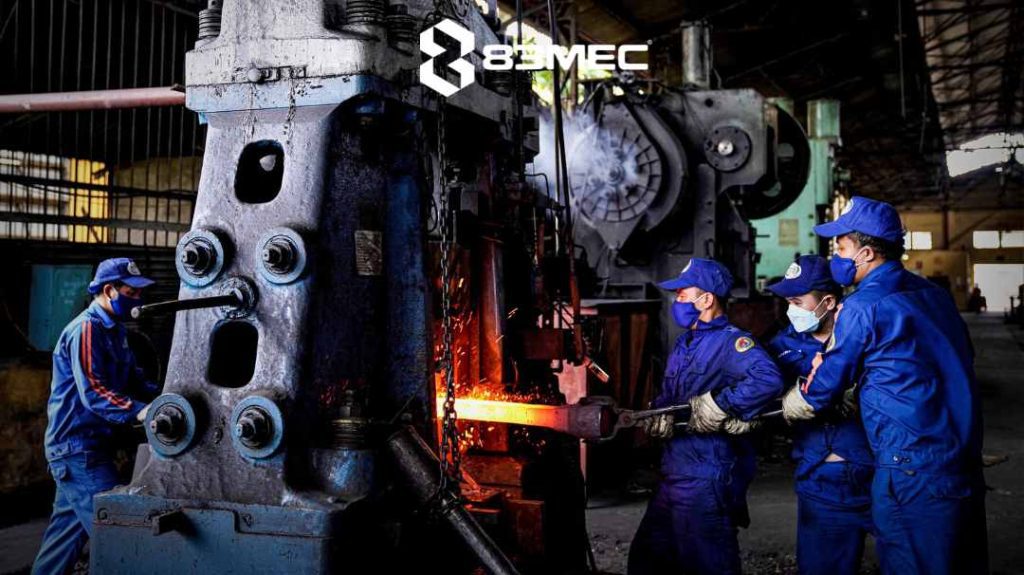During the country’s restoration process, several industries have thrived and have made significant achievements during the previous several decades. The mechanical processing industry has contributed significantly to the growth of domestic industries.
Many individuals are studying and focusing on several automated processing techniques. Cold stamping and hot stamping are two of them. Stamping is the manufacturing method of producing a billet from sheet material using high compressive forces. Based on its warmth, people identify and name the types of stamping (hot and cold) (hot and cold).
83MEC will provide specific information regarding hot stamping processing in today’s article. This method’s remarkable adaptability has left its mark on numerous essential pieces of equipment that support modern living.
1. The processes of hot stamping and conceptualization
- Hot stamping is one of the most common metalworking techniques. The defining characteristic of the approach is a metal in a desirable state that has been worked under pressure. The malformed embryo then comes into contact with the control of the mold cavity Ingot, rolled, and cast steel are some of the materials utilized in this process. When the workpiece is heated to a specific temperature, it is inserted into the mold cavity, making the explanation easier to comprehend. The product’s form and features are fashioned with a considerable deal of power by skilled employees (based on the available mold).
- Direct hot stamping dies are used to distort metals, allowing them to create molds as planned by the craftsman.
- Note: Numerous individuals have confused hot stamping with metal casting. Nonetheless, they are fundamentally distinct. The metal forming on the forging is melted and put into the die before casting stamping. And hot stamping is the reverse technique. In other words, the metal being forged has not been heated.
2. The crucial aspect of the method
- This approach facilitates the production of massive pieces and forms.
- The mechanical durability of products produced by hot working
- Moreover, the product is manufactured with high shine and precision.
- This approach facilitates a high rate of mechanization and automation.
- After the processes of forging and hot stamping, the quality of the end product is multiplied compared to other metal processing technologies. This is also the procedure’s core: the hot hit variable serves as the standard variable, and the width of the query is optimized for good quality. Undoubtedly, perseverance increases the safety of others nearby.
3. Disadvantages of hot stamping
- The worker must do the first forging of the component by hand (manually).
- Mold is not resilient
- Because alloy steel is used for the mold, the manufacturing costs are considerable.
- The manufacturing procedure for the cavity of the mold is complex. A skilled worker must therefore operate a specific machine (also known as an electric spark machine).
4. Discover the attributes of hot stamping dies.
- This mold pressurizes molten metal to achieve the desired product form and dimensions.
- This mold is primarily used for high-temperature product formation. Hence, they require appropriate temperature resistance, excellent hardness, and durability.
- Unlike cold stamping dies, which can only deform soft and uniformly deformable billets, hot stamping dies may distort hard and thick workpieces. Before a material can be processed, it is unavoidable to be heated to a specified temperature. This facilitates the cross-molding process.
5. Die for hot stamping and composition
- Because the primary function of this mold is to make goods at high temperatures, the composition must meet a number of stringent standards, including durability and high resistance to pressure. This is required to secure the appropriate outcome when stamping completed products.
- Resistant to high temperatures (when metal is hot), the maximum temperature is 10,000 degrees Celsius.
- Excellent wear resistance
- Above is the material provided by 83MEC to help consumers understand hot stamping processing methods and hot stamping dies. 83MEC, which is proud to be one of the most reputable and experienced claw stamping units, accepts a variety of simple and intricate details. We are committed to product quality, customer happiness is always our number one priority, and production costs are continuously optimized for the customer.
It is anticipated that the mechanical processing business will continue to expand, eventually becoming a spearhead industry that supports and encourages the modernization of other sectors. This industry offers numerous development options and attracts many significant domestic and global investors due to its future potential.




